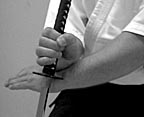
Now, the details

Now, the details
In this third text on the Aiki Batto sword exercise system, I hope to be able to explain my reasons behind making the ten exercises of the so-called Shoden set. This takes me into some details of each of the exercises, which is why I add the URL to the presentation of each.
To start by summing it up: itís all a matter of teaching. I am reminded of Musashiís words in Go Rin no Sho: the teacher is the needle, the student is the thread.
So, to teach you must be bold and go ahead - but when the work is done, the students remain, holding it all together, while the teacher has no function anymore.
I needed a system for my aikido students to practice and understand some of the sword art basics. Therefore, you will find that my reasons for putting together the exercises as I did, always boil down to pedagogics. Still, there are also choices made from my understanding and belief regarding the martial arts and their perspectives. I have allowed myself to construct the Aiki Batto in accordance with what I personally find to be the most sound, the most convincing and trustworthy. Others may make other choices, and surely have good reasons for them. Truth is a process.
Here is how I have reasoned:
Why ten?
The first that comes to an inquisitive mind, is why I have made ten exercises - not, say, six or 22. Actually, in the process of creating them, that came last.
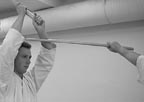
I simply put together exercises, one after the other, until I
felt that I had included the techniques and combinations called for in
a basic Shoden set. They happened to be ten.
Well, I wanted to keep the number down, so it was unlikely that I would allow for that many more than ten, though I would not have objected to fitting everything into just six or so - but that was not possible, if not allowing each exercise to be a series of attacks and defenses, like regular fencing.
This I did not want to allow. Each exercise had to be short, little more than one attack and a decisive defense on it.
Wham bam...
In a basic understanding of the Japanese sword arts, it must be realized that it is not likely with a lot of exchange of blows, like in movies about Sir Lancelot and the like. In principle, and I would guess in historic reality, it is more of a wham, bam. The first attack, if succeeding, immediately ends the duel - if failing, is ended by the counter attack. Thatís it.
It is in the nature of the katana - its sharpness, the way it is handled. Also, it is an important principle of budo - the now, and not the next.
So I made the Shoden exercises very short. I plan, though, in the coming Okuden sets, to allow for more prolonged events.
Everything in pairs
Early in the process of creating the exercises, I found out that it would be very reasonable to divide them into pairs. It has two advantages: one being that you then explore a certain aspect from two angles, the other being that the full set is easier to remember for the student, as they can group the exercises - well, a bit like rhymes.
Maybe it also helps introducing the students to an in-yo (yin-yang) way of thinking, which is so central to all East Asian philosophy. The two sides of things, the opposites uniting, and so forth. This is also evident in budo terminology, which very often has a pair of terms, opposites, needing to be considered. It is especially present in aikido, with its omote-ura, irimi-tenkan, and so forth.
In another dimension of the twine, how natural is it not for the student to ask, after trying out an exercise, to say: "But what if..." The pairs may not be universal, reciprocal answers to any "what-if", but they stimulate the student to find out for him or herself.
The pairs of Aiki Batto exercises are clearly presented in this table: http://www.stenudd.com/aikibatto/table.htm
First a foursome
I have to start by breaking the rule explained above: the first exercises are actually a foursome - the four directions of front, back, left and right. Still, they could be paired - front and back, left and right. I present them as a foursome - Shiho - because this is basic budo, and the idea of those four directions is of almost cosmological significance, not only in East Asian thinking. A budoka not practicing the four directions risks becoming far too narrowminded, locked to prerequisites which may not always be the case.
So, I constructed the first four exercises as sort of one and the same, only changing to the minimal extent needed because the attacker comes from different directions. It is important for the student to see, that a good movement should be applicable to several situations, not just one - but also that any movement, no matter how clever, needs some adaption to specific circumstances. In other words: open mind.

The first exercise must be a mae, to me that is obvious. The mae
is not only a simple way of dealing with a straight attack from the front,
but a sort of declaration of content for the whole sword school, or in
this case the whole series of exercises. So much is stated about strategy,
principles, attitude. It can be compared with the opening scenes of a movie.
Just about everything has to be told.
So, in the Aiki Batto mae, some choices are presented. For example, it does not start in seiza, sitting. I prefer to postpone that to the Okuden set, simply because the sword arts firstly and naturally relate to standing up, walking about. Yes, I think there is in many iaido schools far too much sitting down. With the katana, this makes little sense - though with wakizashi or tanto, it would be more understandable.
Well, in aikido there is suwariwaza, training on oneís knees, and thatís a big curriculum. It is a fine physical exercise - if you have good knees when you start learning it - and it teaches balance, economy of movement and much more. Still, is it good enough to be done close to half of the time, or maybe more, already for the beginner? I doubt it.
Thatís a choice of mine, certainly controversial to many.
Furthermore, in mae the defender starts with sword in scabbard - normal in iai, of course, but rare in aikido sword exercises. Anything else would be less of an introduction to the sword arts, but more importantly: it would be aggression. If both have their swords drawn at the beginning, what is to say the one is an attacker and the other not?
Also, I salute the principle of the kamae which is no kamae: the defender should start from a position seemingly unready, to learn always to be ready without having to show it. One cannot live oneís whole life with oneís sword drawn (also in a metaphorical sense).
Next, mae shows the strategic basics: not stopping or blocking the attack, but using it with a timing that is simultaneous and ends the duel right after the attacking blow is completed: ta-da.
Once this is established in the first exercise, it is permissible to make small deviations from it in the following.
Much more is stated in the "opening scene" of mae, such as how
to move oneís sword as well as oneís body, but I do not think these kinds
of aspects are much different in Aiki Batto from sword arts in general.
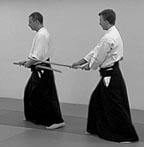
After so many words on mae, I donít think too much needs to be added
about ushiro. One thing, though: regarding the timing of it, I did not
want to demand too much of speedy action from the one who is surprise attacked
from behind. A move to the side to avoid the cut, nothing more, initially.
Thatís enough to hope for, in a situation of that kind.
This moving away, though, is a valuable technique in itself, deserving to be exercised. I tell my students that they should think of it as a reflex movement, when sensing the attack from behind - hearing it, getting a glimpse of it, or even actually sensing it without perceiving it. When training it, I ask of them to turn their heads and look at the attacker from the beginning - to avoid accidents.
I actually believe that this sort of training - in spite of the precaution of looking back from the start - heightens the awareness to a point when chances are increased that an attack can be sensed before physical evidence of it is perceived. I jokingly say that this takes some time, hinting that I mean a very long time indeed, but my personal experience is that this instinct, if that is the word, really comes quickly.
Myself, I had some convincing experiences along this line, only a few months after I started practicing aikido. Of course, that was in my teens - a time of life when one is quite receptive.
Ushiro, just as mae, stresses the importance of commencing with grabbing oneís sword and drawing it - before even knowing whatís going on. That too, is good to rub in.
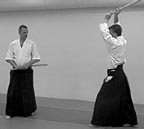
With the pair of left and right, I see the attack coming from around the corner of a building, or some other obstacle. Therefore, the attacker is invisible beforehand, hidden behind the wall. If this were not the case, there would not be much point in practicing left and right attacks particularly - when the attacker is spotted before charging, it will turn into mae. Who does not face an adversary straight on, when given the time to do so?
For the hidari exercise, this does not make much difference, except the importance of understanding the timing for both attacker and defender. The attacker, hiding behind a wall, also cannot see the other beforehand, and therefore is unable to charge before the defender appears from behind the wall. That gives the defender some chance to react.
Another interesting thing to be aware of, is that the attacker cannot stand too close to the corner, at least not with a chudan kamae, or the defender would spot the sword and be warned - before the attacker sees the defender! So, the attacker has to stand a few steps back from the corner, which again gives the defender some additional chance to react.
If the attacker were to stand in jodan kamae, the position could be closer to the corner. In such a situation, I wonder if there is much chance for the defender to avoid the attack at all. If not, whatís the point in training it? So I stick to chudan kamae, and the distance called for.
Letís say that even a lurking attacker feels safer with the chudan kamae than with the jodan.
In the first two exercises, the defender makes a chudan cut, but
in hidari and migi it is gedan. The first is the most basic, fundamental
of the Japanese sword arts, but the gedan cut is a very good way of learning
to relax oneís shoulders in cutting, and therefore helps improve the cutting.
Also, it is a basic cut, needing to be included in an exercise system.
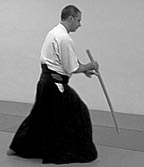
The chiburi and noto also differ from the first two exercises.
I intended to let the student try out several different chiburi and noto,
just to widen the experience - and to have some fun. I have tried to link
each chiburi to the exercise where it seems the most appropriate, the most
fitting, and the noto following depends with the same logics on what chiburi
is used.
This particular chiburi and noto I learned from Nishio Shoji,
8 dan aikido shihan. I have not seen it elsewhere - have you?
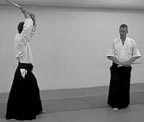
In other sword art solutions I have seen to a migi attack, this is not considered, but to me it seems like an interesting aspect to work on. So, in the Aiki Batto form of migi, the movements are consequences of the attackerís left side not being accessible. Instead, the defender moves to the right side of the attacker, adjusting the yokogiri cut immediately following the draw accordingly.
Also in the continued movement of the sword, the drawing to jodan kamae, the wall on the defenderís right side must be considered - there is not room for a horizontal sweep to the right, as in previous exercises. Instead, the sword is spun around vertically.
In all the four exercises of the shiho set, a straight cut is used at the end, and not a diagonal. For this there are two reasons: one being the simple fact that the straight cut is the most basic, needing the most training - which is why it is also the most frequent technique used by the attacker. The other reason is more so to speak surgical: a straight cut is not very practical on a person standing straight - too much hard stuff to cut through - but after having been hit with the yokogiri, the attacker is most likely to be bending forward, so that the straight cut does in effect cut as a kesagiri would.
I beg your pardon for this rather nasty aspect of it, but as we
all know, such things also need to be contemplated, in order to understand
the sword arts.
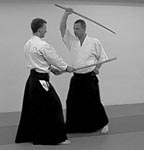
Now, we leave the four directions to focus on an attack from the
front in all the remaining exercises. This makes sense to me, since an
attack from any direction is quickly turned into a mae situation if the
defender has time to turn toward it - and that should have been learned
by the previous foursome.
The following pair is a study of the uke nagashi warding off of the attackerís sword - a technique of vast importance in the sword arts, and also in martial arts without any weapons. In one or other variation, it exists in aikido as well as karatedo, and I find it ever so useful in numerous situations.
This should be understood: in the sword arts, uke nagashi is not primarily a parry, but a way of drawing the sword to jodan kamae, having also the additional benefit of being a good parry. But the best way to avoid a sword attack is to move away from it - rarely is it trustworthy to stand oneís ground and try to block or ward off a blade swung in oneís direction.
Step away! And draw the sword simultaneously. To me, thatís optimal. The uke nagashi position of the sword, then, should be such that it can be immediately followed by a cut - no additional adjustment of the sword position should be needed first. Again the rhythm of ta-da.
Omote is an exercise of this very basic ta-da: draw the sword in an uke nagashi move, then cut immediately. In this case - as opposed to the previous exercises - the attacker is still standing straight, wherefore a kesagiri cut is used instead of a straight one. This also comes naturally after the uke nagashi move.
It is possible to do this movement very quickly - or the attacker
would have time to draw for a new cut.
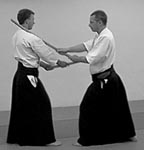
In the ura, on the other hand, we presume that the attacker is fast
enough to have time to draw before a kesagiri can be executed. To make
this more likely - and to prepare the student for alternative movements
of the attacker - this attack is men, and not a cut all the way down to
chudan level. From a men cut, the next cut comes very quickly indeed, with
someone well trained with the sword.
And this second cut of the attacker will not be in the same direction as the first one, but to the left (seen from the attacker), since that is the new position of the defender. This is important to be aware of. That is why the defender moves to the other side - the attackerís right. It is very difficult for the attacker, having turned to the left for the next cut, to suddenly turn back toward the right.
In aikiken exercises, I have often seen a lack of awareness on this: the attacker sort of blindly goes on to attack in the direction the defender was at the beginning, but never returns to. Not much point in that.
So, one of the key intentions of the ura exercise is to make the student conscious of these dynamics, in the change of directions between attacker and defender.
At the chiburi, the defender starts with a step back, so as not
to be unbalanced when doing the chiburi movement. This is also something
the student needs to be aware of - the fact that at an extended stance
with the left foot forward, there is a lack of balance if pulled even slightly
to the forward right (and vice versa). Every stance has its strong and
weak points. With this adaption of the chiburi, that important fact is
pointed out.
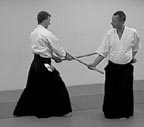
Leaving the uke nagashi, we now study the kote in a pair of exercises.
The kote is well appreciated in kendo, certainly, but I believe that in
other sword arts - also in aikiken - its efficiency is usually underestimated.
The swordsman needs the sword, and the sword depends on the hands, the
wrists of which are actually the least protected in the guards and movements
of the sword arts. Terrific targets, then, and often more easy to get at
than any other part of the body.
Also, in this pair of exercises, I put attention to the two most important levels - chudan and jodan. Since the kote is a small target, it is very important to know where to find it, when the attacker holds the sword at different heights. Practicing the kote cut, you become quite aware of the difference of chudan and jodan - they feel like a mile apart.
The chudan exercise is to me pretty much a mae, with just another timing to it. If the attacker charges too quickly for the defenderís sword to both be drawn and to cut before the attackerís cut is completed - then, the kote chudan is an alternative, allowing the defender some more time, though not a lot of it. In the sword arts, there is never a lot of time.
The first move is simply a step to the left, out of the way of the attacking sword, and a draw simultaneously. Then the kote.
The exercise could very well end there, with the idea of cutting through the attackerís wrist and be done with it - but the attacker is likely to have two arms, so there could be a one-handed attack following. That is why the exercise goes on. It must be understood that kote is never a final technique.
And here comes a manoeuver which might have more relevance to the aikidoka than to the swordsman, nevertheless practical to both. The defender is using the sword to control the attackerís next move, to sort of guide it. This way, the attacker has little else to do than draw to jodan for a new cut, and by this opens for the yokomen.
The reason for yokomen is primarily in how the sword is moved previously - the most natural follow-up is yokomen - but of course, there is also a need for exercising this important cut when given a good chance.
The chiburi used here, a well known one indeed, I find ideal to perform after a yokomen. Actually, I think they suit each other so well, the yokomen and this chiburi, that the combination should be used for anyone wanting to learn this very difficult, sometimes awkward chiburi.
The attacker starts from migi no waki, right side guard, in this
pair of exercises, after having done pretty much the same thing in the
previous six. Time for a change, no doubt, and also for the defender to
experience the slightly different timing of this attack. Furthermore, there
is an interesting contrast between the great force of the attack from the
side guard, and the precise technique of the kote cut, saying something
about how the small conquers the big, the soft surpasses the hard, and
so forth.
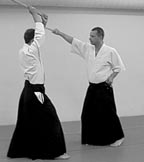
This exercise is inspired from Musashi, who describes something
like it in his Go Rin no Sho - among the very few techniques he actually
mentions in any detail. It is a bit dangerous to practice - with Musashi
at its root, that can come as no surprise - so caution must be used.
What is most rewarding here, is the understanding it gives to timing - the defenderís sword should hit the attackerís wrist just as the arm is coming down in the attacking cut. Not too early, or you miss the kote, and not too late, or the angle will not be good enough to cut through. At the optimal moment, the attacker unwillingly helps with the kote cut.
Angles are important. The defenderís sword must be extended to hit with the right part of the sword, and when the angle between the defenderís arm and sword is such that the cut is strong. It takes some training, but the student learns so much about the sword arts in the process.
I really have a feeling that if this move cannot be properly executed by the student, then he or she is really unable to do a lot of other things with the sword, which may seem easy enough.
When it comes to the final cut, the yokomen, I allowed myself to introduce another difficulty, which might be a bit out of touch with the Shoden basic thinking otherwise applied. The easiest would probably be to allow the sword to continue through the kote cut, and spin around at the end of it. Instead it is stopped after kote, and then flipped.
There is a basic teaching aspect to this choice, also: if allowed to continue the cut and spin the sword around, the student will not be able to perceive how precise the kote actually was - in what angle the sword hit the wrist, with what strength, and so forth. Stopping after it, will make that obvious.
And with the following yokomen, the student needs to learn how
to make a strong cut although not having a lot of distance to accelerate
the sword - a bit like the one inch punch of fist fighting arts. It takes
precision, focus, a good center - and a lot of practice. I canít say that
I master it myself, in case you wondered - but I have great fun trying.
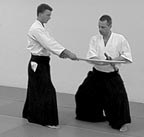
The last pair of exercises in the Aiki Batto Shoden, focuses on
harai, also spelled barai, the warding off. This can be done in a number
of ways, for example as in the uke nagashi of exercise five and six, where
the blade is used. Here, though, the harai is done with the tsuka, the
hilt, as the sword is not yet drawn. This may not be a very commonly used
technique in the sword arts, for the simple reason that the sword is drawn
as quickly as possible, very often before the first attack.
But in the typical iaido case, as in Aiki Batto, where the defender always starts with sword in scabbard, some techniques with the hilt should be practiced.
I take the opportunity to introduce another attacking technique as well - tsuki, the thrust. Although it is a basic technique with the sword, and a very efficient one at that, it is my experience that defense against it is not practiced nearly enough in regular aikiken.
Dealing with a tsuki attack can be very tricky indeed. The timing is different from that in a cut, and many are so used to practicing defense against a cut, that they cannot even imagine a tsuki coming. They allow themselves to stand too near the attackerís sword to begin with, and too late do they perceive that what is coming is a thrust, not a draw for a cut. The tip of the sword in a chudan kamae position must be respected, and training defense against tsuki accomplishes just that - very quickly, too. It also teaches the student to establish a proper ma-ai, distance, to the attacker.
Actually, as can be detected from the above, I regard the defense training against a tsuki attack more important in these last two exercises, than the actual harai being used. Because tsuki can be quite a surprise, and usually leaves less time to act for the defender than a big cut does, the warding off is done with the defenderís sword still in the scabbard.
In the first of the two exercises, the student also learns that the undrawn sword can be used as a weapon - the ate, hit, is done with the tsuka. When the sword is used like this, it is actually important to keep the sword firmly in the scabbard, or all kinds of mishaps can come. That, too, is good to familiarize oneself with, as an example of optimizing an alternative road of action.
The ate here is both a strike at the attacker, and a way of pushing him or her back, to give room for the draw of the sword. Since these are movements needing to be done swiftly, and with the attacker close by, it is a good situation to apply the left hand support of the blade in the yokogiri, to give it some additional strength and stability. Again, a way of optimizing a rather unusual road of action.
The chiburi used here, I find particularly suitable for a chudan
kamae position, whether it be reached with a cut, as here, or a tsuki,
as in the final exercise. I have chosen the way to do noto, taught by Nishio
sensei, since I find it more controlled than other solutions for it.

In the last exercise, the harai is done on the right side of the
attackerís sword, and this time the defender gets to respond with a tsuki.
One of the things to practice here, is the draw of the sword, which should be in a smooth continuance of the harai. Because of the position of the sword after this type of draw, a tsuki comes naturally. Also, similar to the case of the jodan kote in exercise eight, the attacker rushes into the technique, thereby unwillingly helping in it. An understanding of timing is needed to make this work well.
The ninth and tenth exercise are a bit more out of the ordinary than, say, the first four, and this is intentional. Actually, I hope that the series works as an escalation of complexity and technical difficulty. Of course, in the sword arts there is nothing more essential or more difficult, than learning the basic cut properly - but for the students it is of some attraction if they can feel that they move toward more intricate ways of using the sword. It also has the advantage of preparing them for the Okuden series, which I plan to add, given time.
In the Okuden there are some additional aspects of the sword arts to be exercised: mainly duels with a series of movements, where also the attacker wards off some counter blows, and defense against multiple attackers. But that is yet to come.